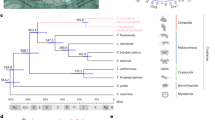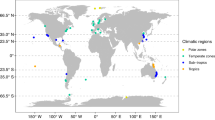Abstract
A WORLDWIDE increase in toxic phytoplankton blooms over the past 20 years1,2 has coincided with increasing reports of fish diseases and deaths of unknown cause3. Among estuaries that have been repeatedly associated with unexplained fish kills on the western Atlantic Coast are the Pamlico and Neuse Estuaries of the southeastern United States4. Here we describe a new toxic dinoflagellate with 'phantom-like' behaviour that has been iden-tified as the causative agent of a significant portion of the fish kills in these estuaries, and which may also be active in other geographic regions. The alga requires live finfish or their fresh excreta for excystment and release of a potent toxin. Low cell densities cause neurotoxic signs and fish death, followed by rapid algal encystment and dormancy unless live fish are added. This dinoflagellate was abundant in the water during major fish kills in local estuaries, but only while fish were dying; within several hours of death where carcasses were still present, the flagellated vegetative algal population had encysted and settled back to the sediments. Isolates from each event were highly lethal to finfish and shellfish in laboratory bioassays. Given its broad temperature and salinity tolerance, and its stimulation by phosphate enrichment, this toxic phytoplankter may be a widespread but undetected source of fish mortality in nutrient-enriched estuaries.
This is a preview of subscription content, access via your institution
Access options
Subscribe to this journal
Receive 51 print issues and online access
$199.00 per year
only $3.90 per issue
Buy this article
- Purchase on Springer Link
- Instant access to full article PDF
Prices may be subject to local taxes which are calculated during checkout
Similar content being viewed by others
References
Hallegraeff, G. M., Steffensen, D. A. & Wetherbee, R. J. Plankt. Res. 10, 533–541 (1988).
Robineau, B., Gagne, J. A., Fortier, L. & Cembella, A. D. Mar. Biol. 108, 293–301 (1991).
Shumway, S. E. J. World Aquaculture Soc. 21, 65–104 (1990).
Miller, K. H. et al. Pamlico Environmental Response Team Report (North Carolina Department of Environment, Health and Natural Resources, Wilmington, 1990).
Smith, S., Noga, E. J. & Bullis, R. A. Proc. 3rd Int. Colloquium Path. Mar. Aquaculture 167–168 (1988).
Ryther, J. H. Ecology 35, 522–533 (1954).
Roberts, R. J., Bullock, A. M., Turner, M. K., Jones, K. & Tett, P. J. mar. Biol. Ass. UK. 63, 741–743 (1983).
Taylor, F. J. R. in The Biology of Dinoflagellates (ed. Taylor, F. J. R.) 24–92 (Blackwell, Boston, 1987).
Taylor, F. J. R. in The Biology of Dinoflagellates (ed. Taylor, F. J. R.) 723–731 (Blackwell, Boston, 1987).
Sokal, R. R. & Rohlf, F. J. Biometry 2nd edn (Freeman, San Francisco, 1981).
Thorp, J. H. & Covich, A. P. Ecology and Classification of North American Freshwater Invertebrates, 77 (Academic, New York, 1991).
Spero, H. J. J. Phycol. 18, 357–360 (1982).
Gaines, G. & Elbrachter, M. in The Biology of Dinoflagellates (ed. Taylor, F. J. R.) 224–268 (Blackwell, Boston, 1987).
North Carolina Department of Environment, Health and Natural Resources 1990 Algal Bloom Reports (North Carolina Department of Environmental Management, Raleigh, 1990).
North Carolina Department of Natural Resources and Community Development 1986 Algal Bloom Reports (North Carolina Division of Environmental Management, Water Quality Section, Raleigh, 1987).
North Carolina Department of Natural Resources and Community Development 1987 Algal Bloom Reports (North Carolina Division of Environmental Management, Water Quality Section, Raleigh, 1988).
North Carolina Department of Natural Resources and Community Development 1988 Algal Bloom Reports (North Carolina Division of Environmental management, Water Quality Section, Raleigh, 1989).
Palenik, B., Kieber, D. J. & Morel, F. M. M. Biol. Oceanogr. 6, 347–354 (1988).
Lagler, K. F., Bardach, J. E. & Miller, R. R. Ichthyology 268–272 (New York, 1962).
Smayda, T. J. in Novel Phytoplankton Blooms (ed. Cosper, E. M. et al.) 449–484 (Springer, New York, 1989).
Stanley, D. H. in Proc. Symp. Coastal Water Resources 155–164 (American Water Works Association, Wilmington, 1988).
Rudek, J., Paerl, H. W., Mallin, M. A. & Bates, P. W. Mar. Ecol. Prog. Ser. 75, 133–142 (1991).
White, A. W. Mar. Biol. 65, 255–260 (1981).
White, A. W. in Proc. Int. Conf. Impact of Toxic Algae on Mariculture 9–14 (Aqua-Nor 1987 Int.Fish Farming Exhib, Trondheim 1988).
Author information
Authors and Affiliations
Rights and permissions
About this article
Cite this article
Burkholder, J., Noga, E., Hobbs, C. et al. New 'phantom' dinoflagellate is the causative agent of major estuarine fish kills. Nature 358, 407–410 (1992). https://doi.org/10.1038/358407a0
Received:
Accepted:
Issue Date:
DOI: https://doi.org/10.1038/358407a0
This article is cited by
-
Future distribution patterns of nine cuttlefish species under climate change
Marine Biology (2023)
-
Application and comparison of two symptom-based eutrophication-assessment methods in Jiaozhou Bay, China
Journal of Oceanology and Limnology (2019)
-
Effects of a harmful algal bloom on the community ecology, movements and spatial distributions of fishes in a microtidal estuary
Hydrobiologia (2016)
-
Naming, Framing, and Blaming: Exploring Ways of Knowing in the Deceptively Simple Question “What is Water Quality?”
Human Ecology (2014)
-
Harmful and parasitic unicellular eukaryotes persist in a shallow lake under reconstruction (L. Karla, Greece)
Hydrobiologia (2013)
Comments
By submitting a comment you agree to abide by our Terms and Community Guidelines. If you find something abusive or that does not comply with our terms or guidelines please flag it as inappropriate.



